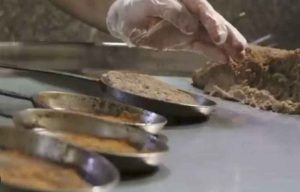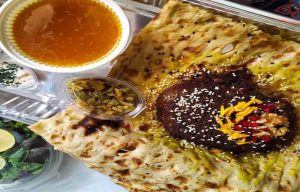Persian Biryani: The delicious taste of Isfahan

Persian Biryani is a traditional food of Isfahan city in Iran, which is very nutritious. This food is served in abundance in this city. All travelers and tourists who have entered this city must have tasted this delicious food. Complete your Persian feast with a sweet touch by trying our Zoolbia Recipe a traditional crispy and syrupy dessert from Isfahan. This delicious dish, like Jaghoor Baghoor, uses fresh liver, but the cooking method is different, and it tastes similar to kebab.
Isfahan Beryani can be found in many restaurants in Isfahan, but you can easily prepare it at home. In this article, we have prepared for you how to cook Persian Biryani. By eating Iranian Biryani, you can travel to the depths of the taste of food in Isfahan.

Necessary ingredients for Persian Biryani
In this dish, the basic ingredients are written according to the mood of the Iranians, so you can use some taste for it, but pay attention not to change the main ingredients.
| Mutton | 500 grams |
| Tail | 50 grams |
| White liver | 100 grams |
| Onions | 2 large |
| liquid oil | Enough |
| Salt and black pepper | Enough |
| Dry mint | 1 teaspoon |
| Cinnamon | 1 teaspoon |
| Brewed saffron | 1 teaspoon |
| Sliced pistachios, almonds and walnuts | Needed |
How to Prepare Authentic Persian Biryani
Step 1: Cook the Meat
Place a pot over medium heat and sauté the chopped onions in a bit of oil until translucent. Add the chopped mutton and tail fat, frying until the color changes. Then add 4 cups of water, cover, and let it simmer for about 2 hours until the meat is tender.
Step 2: Season and Grind
Remove the cooked meat and fat from the pot. Grind them together and season with salt, black pepper, dried mint, turmeric, and saffron. Grind once more for a smooth texture.
Step 3: Prepare the Liver
In a separate pan, cook the white liver with salt, pepper, turmeric, and one chopped onion in 3 cups of water. Once the liquid evaporates, fry it lightly, then grind it just like the meat mixture. Add saffron and grind again.
Step 4: Shape and Cook
Traditionally, Isfahan Biryani is cooked in round copper pans that shape the mixture like a burger patty. If you don’t have these, a small frying pan works perfectly. Spread the meat mixture evenly, press it down, and fry both sides on low heat until golden.
Step 5: Serve and Enjoy
Serve your Persian Biryani hot, garnished with nuts, alongside fresh herbs, buttermilk (doogh), or curd broth. It pairs beautifully with Persian flatbread or saffron rice.

Persian Biryani (Isfahan Beryani)
Ingredients
Method
- Step 1: Cook the Meat
- In a pot, heat a little oil and sauté chopped onions until soft.
- Add mutton and tail fat, fry until lightly browned.
- Pour in 4 cups of water, cover, and simmer for about 2 hours until tender.
- Step 2: Grind and Season
- Remove the cooked meat and fat, and grind them together.
- Add salt, pepper, turmeric, saffron, cinnamon, and dried mint.
- Grind again until smooth and well blended.
- Step 3: Cook the Liver
- In a separate pot, cook the liver with salt, pepper, turmeric, and one chopped onion in 3 cups of water.
- Once the liquid evaporates, fry it for a few minutes and grind it like the meat.
- Add saffron and mix well.
- Step 4: Shape and Fry
- In a small non-stick pan, spread a portion of the mixture and flatten it.
- Fry both sides over low heat until golden brown.
- Step 5: Serve
- Serve hot with fresh herbs, Persian bread, or saffron rice.
- Enjoy with a glass of buttermilk (doogh) or curd broth for an authentic Persian experience.
Important points of Isfahan Beryanii
- It can be used with biryani, curd broth, buttermilk, and basil.
- It is better to serve this dish with homemade or bulky bread.
- Meat, white liver and tail are the main basis of this.

The benefits of Persian Biryani
- Preventing anemia and increasing body endurance
- Bone strength and prevention of osteoporosis
- Increase sexual power
- Strengthening thin people and making them fat

The disadvantages of Persian Biryani
- Because this food is high in calories, it is recommended to include it in lunch
- High fat and increases cholesterol
- Weight gain and obesity
What is Biryani Isfahan?
Biryani Isfahan is a traditional Persian version of biryani that differs from the more widely known Indian or Pakistani styles. Unlike the layered rice and meat cooked together in classic biryani, Isfahan biryani separates the meat and rice, serving tender, juicy meat pieces alongside aromatic saffron rice. The meat, typically lamb or beef, is marinated with local spices and slow-cooked to perfection, often accompanied by a rich tomato-based sauce and grilled tomatoes.
The History of Biryani in Iran
While biryani’s origins are traced back to the Indian subcontinent, the dish made its way to Iran centuries ago, adapting to the local tastes and ingredients. The Iranian version of biryani, especially biryani Persian, incorporates Persian culinary techniques, including the generous use of saffron, dried lime, cinnamon, and other spices native to the region.
Ingredients of Isfahan Biryani: A Blend of Persian Flavors
One of the reasons why Iranian Biryani stands out is the distinct combination of ingredients that showcase Persian tastes:
-
Meat: Usually lamb or beef, marinated in garlic, onions, turmeric, cinnamon, and other Persian spices.
-
Rice: Long-grain basmati rice, soaked and cooked with saffron for that signature golden hue and aroma.
-
Tomato Sauce: A rich, tangy sauce made from tomatoes, onions, and a hint of dried lime, adding depth and brightness.
-
Grilled Tomatoes: Often served on the side or on top, grilled tomatoes add a smoky sweetness.
-
Spices: Saffron, cumin, cinnamon, cardamom, and sometimes dried rose petals for an extra floral aroma.
-
Butter or Oil: Used generously to add richness.
This combination makes Isfahan biryani a perfect representation of Persian gastronomy aromatic, balanced, and satisfying.
How is Persian Biryani Different from Other Biryani?
While many are familiar with the layered style of biryani from India or Pakistan, Persian biryani takes a different approach. Here’s how biryani Persian stands out:
-
The meat is cooked separately from the rice, ensuring tenderness and juiciness.
-
Rice is typically plain saffron rice, not layered or mixed with meat during cooking.
-
The use of Persian spices such as dried lime and cinnamon gives it a unique flavor profile.
-
Tomato sauce accompanies the dish rather than mixing directly into the rice.
-
Presentation is simpler yet elegant, focusing on the quality of each component.
These differences make biryani in Iran a distinct and memorable dish for anyone looking to explore Persian cuisine beyond the usual kebabs and stews.
The Cultural Significance of Isfahan Biryani
In Isfahan, biryani is more than just a meal it’s a social experience. Traditionally served during family gatherings, special occasions, and celebrations, Iranian Biryani embodies the warmth and hospitality of Persian culture. Many locals consider it a must-try dish for visitors and take pride in the recipe’s authenticity.
Nutritional Benefits of Persian Biryani
Besides its incredible taste, biryani Persian is also rich in nutrition:
-
High in protein thanks to the generous meat portion.
-
Contains complex carbohydrates from basmati rice, providing sustained energy.
-
Includes spices like turmeric and cinnamon known for their anti-inflammatory properties.
-
The use of saffron, rich in antioxidants, adds health benefits along with its luxurious flavor.
In the End
If you’re looking to explore traditional Iranian dishes, Persian Biryani from Isfahan is a must-try. This rich and flavorful meal reflects the heart of authentic Persian cuisine, combining tender meat, saffron, and warm spices. Cook this Persian Biryani recipe at home and experience the unique taste of Isfahan food a perfect balance of tradition, flavor, and culture.
Frequently Asked Questions about Persian Biryani
1-What makes Persian Biryani different from Indian or Pakistani Biryani?
It’s made with ground lamb served separately from rice, using saffron and cinnamon instead of spicy masalas.
2-Can I make Persian Biryani without lamb?
Yes, you can use beef or chicken, but lamb gives the most authentic flavor.
3-What is the best side for Persian Biryani?
Traditionally served with Persian bread like sangak or taftoon, or saffron rice.
4-Is Persian Biryani spicy?
No, it’s mild and aromatic with saffron, cinnamon, and dried mint.
5-Can I prepare Persian Biryani ahead of time?
Yes, cook and grind the meat mixture in advance, then reheat and fry before serving.

[…] Persian Biryani is one of the most famous and authentic traditional foods of Isfahan, which is rich in protein and calories. Persian Biryan […]